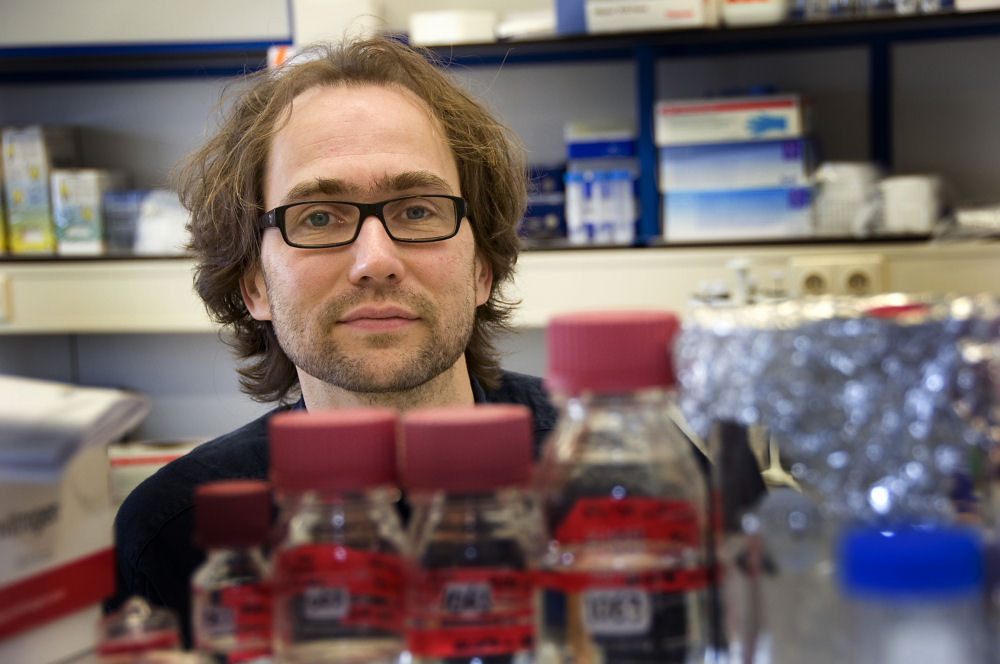
Una veduta dell’Erasmus Medisch Centrum di Rotterdam (foto Erasmus MC)
All’Erasmus Medisch Centrum di Rotterdam, in Olanda, è stato compiuto uno studio che potrà essere di grande aiuto nei casi di crimini irrisolti. Si tratta di un test del DNA da cui si può risalire al colore degli occhi e dei capelli dell’assassino.La ricerca è opera dall’equipe di biologia molecolare forense diretta dal Prof. Dott. Manfred Kayser, tedesco, 44 anni, con la collaborazione di colleghi greci e polacchi. La notizia è stata pubblicata dal Forensic Science International: Genetics.

Ancora una bella immagine dell’Erasmus Medisch Centrum di Rotterdam.
Foto Hans Linsen
Abbiamo contattato il Professor Kayser per saperne di più e porgli una domanda precisa: potrebbe servire per le indagini sulla morte di Yara Gambirasio, durante le quali sono stati prelevati 13.000 campioni di DNA senza portare ad alcun risultato? Come ricorderete Yara scomparve il 26 novembre 2010. Il suo corpo senza vita fu rinvenuto tre mesi dopo a Chignolo d’Isola, a pochi chilometri da Brembate di Sopra (Bergamo) dove si erano perse le sue tracce mentre stava tornando a casa dalla palestra in cui si allenava abitualmente.
Aveva solo 13 anni. Il gip Ezia Maccora ha concesso altri sei mesi per proseguire l’inchiesta, altrimenti il caso verrà archiviato. Per i disperati genitori della povera ragazzina si tratta di una lotta contro il tempo, almeno per ottenere che il colpevole venga consegnato alla giustizia.

Il Prof. Dr. Manfred Kayser direttore del reparto di biologia molecolare forense dell’Erasmus Medisch Centrum (foto Erasmus MC)
Professor Kayser, può spiegarci in parole “semplici” in che cosa consiste la vostra scoperta?
Abbiamo sviluppato un metodo per risalire all’identità di persone sconosciute che hanno commesso un delitto. Si tratta di un test del DNA molto sensibile (quindi applicabile anche su campioni piccoli di DNA) atto ad esaminare contemporaneamente 6 “loci”del genoma umano. (Nota di redazione: il termine locus, plurale loci, designa la posizione di un gene all’interno di un cromosoma. Servendosi degli incroci genetici si produce una mappa: il locus indica proprio la localizzazione di ciascun gene utilizzato per formarla).
I suddetti loci sono associati al colore degli occhi. Questo in linea di massima: infatti l’intero procedimento è molto complesso per cui è difficile spiegarlo in poche parole. Gli abbiamo dato il nome di IrisPlex system. Abbiamo poi integrato la ricerca con un altro sistema (chiamato HirisPlex) in base al quale si può stabilire anche il colore dei capelli dell’assassino: in tal caso prendiamo in esame non più 6, ma 24 evidenziatori di DNA.
Questi due test sono importanti, ci tengo a ribadirlo, nei casi in cui la polizia non riesce a trovare l’autore di un crimine solo sulla base di un profilo generale del DNA. Grazie alla nostra procedura il campo di investigazione si restringe molto e non si va avanti alla cieca, con dispendio di energie, tempo e denaro.
Da quanto tempo svolge la Sua professione all’Erasmus Medisch Centrum?
Dal 2004. La ricerca, durata due anni, è stata finanziata dall’Istituto forense olandese, insieme al NGI (istituto di studio sui genomi) e all’NWO (organizzazione per la ricerca scientifica).
E’ un test sicuro?
In biologia nulla è certo al 100%. Tuttavia posso affermare che sulla base dei tests compiuti è possibile prevedere al 99% se gli occhi dell’ assassino sono blu o neri. Mentre con un altro colore ( per esempio il verde), la percentuale si riduce. Circa il colore dei capelli, la sicurezza è del 90% se sono neri, dell’80% rossi o castani, del 70% se sono biondi. A riguardo dobbiamo ancora compiere test su larga scala.
Prima di iniziare l’intervista Le ho parlato del caso della ragazzina italiana Yara Gambirasio, sottolineando il fatto che sono stati prelevati 13.000 campioni di DNA di persone (che abitavano in un paese circostante), con una spesa di migliaia di euro, per confrontarli con quelli delle tracce di liquido seminale trovate sugli slip della povera bambina: senza alcun risultato. Con il vostro test si sarebbero potuti evitare tutti questi prelievi…a tappeto di DNA?
In generale posso risponderle di sì. Dipende anche dal posto dove è avvenuto il misfatto. Se per esempio in quella regione la popolazione ha prevalentemente gli occhi scuri e i capelli neri e il DNA dell’assassino riconduceva a capelli biondi ed occhi blu, si sarebbe potuta compiere una ricerca più mirata con meno persone coinvolte.
Il vostro metodo si può usare anche nel caso di un corpo rimasto a lungo al freddo o all’umidità?
Sì. Serve anche per l’identificazione di un cadavere in stato di decomposizione. Il colore degli occhi e dei capelli può anche cambiare dopo la morte. Il nostro test si può adattare al DNA proveniente da tutte le parti del corpo, quindi anche nel caso venga ritrovato soltanto un braccio o una gamba.

La piccola Yara Gambirasio, uccisa nel 2010 a pochi chilometri da casa sua. Il suo assassino è ancora libero.
Consiglierebbe ai genitori di Yara di rivolgersi al vostro laboratorio? Sareste disposti ad aiutarli?
L’assassino non è stato trovato, nonostante le 13.000 persone a cui è stato richiesto e attuato il test del DNA. Chi ha ucciso Yara non si trova pertanto in quel gruppo di persone. Allora adesso sarebbe necessario ricominciare da capo, magari proprio sulla base dell’Iris e Hiris Plex test; sicuramente con minor spreco di tempo e denaro.
Siamo disposti a mettere a loro disposizione la nostra ricerca ed il nostro aiuto ma solo se ci verrà richiesto ufficialmente da parte della polizia o dal giudice delle indagini preliminari. Non dai genitori privatamente, in quanto abbiamo bisogno anche della collaborazione della polizia.
Quali sviluppi e ampliamenti prevedete in futuro nel campo delle vostre ricerche per risolvere maggiori casi giudiziari?
A livello scientifico c’è ancora molto da fare per perfezionare il nostro test! Vogliamo concentrarci anche sul colore della pelle, della statura e della forma del viso. Sino a poco tempo fa la maggior parte degli studi sul DNA erano basati su fattori ereditari delle malattie. A livello genetico i tests sull’aspetto fisico e sui fattori ambientali sono molto complessi. Per esempio per l’altezza entrano in gioco ben 180 loci. Quindi la strada per arrivare a definire con precisione la statura di una persona è lunga e complicata. Bisogna anche tener conto delle regole stabilite dalla legge sull’uso del DNA nel campo della ricerca forense
Ci sono Paesi in cui è ammessa solo se non è stato scoperto niente via altri codici di identificazione. In Olanda la legge permette questi test per le indagini sulle origini bio-geografiche e l’aspetto fisico. Dall’aprile 2012 anche il nostro sistema è considerato legale. Nel Regno Unito tutto può essere studiato e testato (ovviamente se non ci sono già particolari veti su determinati esperimenti).
Ringraziamo il Professor Kayser per l’intervista e speriamo che le autorità competenti si mettano in contatto con lui: perchè chi ha privato Yara della vita non rimanga libero. E Yara non venga “archiviata” come una pratica d’ufficio senza valore. Vi terremo informati se dopo il nostro servizio verrà contattato il centro olandese di biologia molecolare forense e quali saranno gli ulteriori sviluppi. Per non dimenticare mai non solo lei ma anche tutti i bambini vittime innocenti di menti distorte, cattive e perverse.
Maria Cristina Giongo
CHI SONO
Un ringraziamento anche a David Drexhage portavoce ufficiale dell’ufficio stampa dell’Erasmus MC per avermi aiutata ad ottenere questa importante intervista e per la collaborazione nella traduzione.
Proibita la pubblicazione del testo e delle fotografie senza citare autore e fonte di provenienza.
Traduzione di questo articolo in lingua inglese:
At the Erasmus Medisch Centrum, Rotterdam, Netherlands, a study has been done that can be of great help in unresolved criminal cases.
The study centres around a DNA test from which the eye colour and hair colour of the criminal can be deducted. The research is the work of the forensic molecular biology team headed by Prof. Dr. Manfred Kayser, 44, from Germany, with collaboration from Greek and Polish colleagues.
It has been published by Forensic Science International: Genetics.
We got in touch with Professor Kayser to learn more about this and to ask him a specific question: could it have been of use in the investigation into the death of Yara Gambirasio, during which time 13000 samples were taken without any result emanating from it. As you will remember Yara disappeared on the 26th of November 2010. Her lifeless body was found three months later in Chignolo d’Isola, a few kilometers from Brembate di Sopra (Bergamo) where every trace of her was lost when she returned home from the sports centre where she regularly exercised.
She was only 13 years old. The GIP (Preliminary Hearing Judge) Ezia Maccora has allowed another six months for investigations, otherwise the case will be closed. For the desperate parents of the poor girl it’s a struggle against time, to ultimately have the guilty person handed over to justice.
~~~~~~
Dear Professor Kayser, can you explain us in layman’s terms what the ‘IrisPlex test system’ consists of?
The IrisPlex DNA test system we developed about 2 years ago consists of a highly-sensitive DNA test assay that simultaneously looks at 6 sites in the human genome, which are known to be highly involved in human eye colour variation. The second part of the IrisPlex system is a prediction model based on thousands of individual datasets with eye colour information and DNA information. This model allows translating the DNA information obtained with the test assay into the most likely eye colour a person has.
What we now have developed (and published) is the HIrisPlex test system allowing the prediction of hair and eye colour simultaneously from DNA. Again the system consists of a DNA test assay, this time targeting 24 sites in the human genome that are known to be involved in hair and eye colour variation, and two prediction models one for eye and the other for hair colour that allow translating the DNA information obtained with the test assay into the most likely hair and eye colours a person has.
These DNA tests are useful in those forensic cases were DNA is available from the crime scene but all means of investigation including conventional DNA profiling have not lead to the right suspect (so called cold cases). Being able to predict eye and hair colour with our new HIrisPlex test system from DNA found at a crime scene allows concentrating police investigation in such cold cases. In other words, the police shall not look for everybody but for the smaller group of people that match the eye and hair colour information as predicted from the crime scene DNA using the HIrisPlex system.
Since when have you and your team been studying the new possibility of utilizing the human DNA?
I moved to Rotterdam and became the founding head of the Department of Forensic Molecular Biology at the Erasmus University Medical Center in 2004. Looking into ways how to predict a person’s appearance from DNA was one of the main research lines from the beginning because of the problem of cold cases that was realized by the Netherlands Forensic Institute which is co-funding together with Erasmus MC my department.
Is there already a valid and watertight theory or could there still be cases for which the system is not applicable?
Nothing in biology is 100%. Currently, we can predict blue and brown eye colour from DNA using the IrisPlex or the HIrisPlex system with an expected accuracy of about 95%. This accuracy we know from DNA analysis of many thousands of individuals for which we had eye colour information. However, intermediate eye colours that are not blue or brown (such as green) can be predicted with much less accuracy. Using the HIrisPlex system we can predict black hair with close to 90% accuracy, red hair with 80%, brown hair with close to 80% and blond with close to 70% accuracy. These values are likely to be underestimates of the truelly achievable accuracies as thus far they are only based on many hundreds (but not yet thousands) of individuals for which we have DNA and hair colour data.
This shows that in some individuals and depending on the actual eye and hair colour present, our current DNA tools cannot predict eye and hair colour correctly. However, in a large number of individuals the prediction is correct. We are working on improving these accuracies by searching for more eye and hair colour predictive DNA markers.
However, one shall not forget that such diagnostic tools are meant to be applied to those forensic cases were the police has no clue who the crime scene sample donor might be. Hence, it can be expected that in such cold cases the police is not only willing to use for further investigations a predicted eye colour coming with an accuracy of 98% but also a predicted hair colour coming with an accuracy of 80%, simply because they do not know anything else that is useful for their investigations.
On the 26th of November 2010 a young Italian girl, aged 13, Yara Gambirasio, unexpectedly disappeared while returning home from a sports centre.
Her lifeless body was found 3 months later in a nearby field.
A total of some 13.000 samples of DNA have been taken from people living in the surroundings, costing many tens of thousands of Euros, for comparison with the DNA of the probable assassin (who left traces of sperm on the underwear of the girl), but without result.
With the test that you have discovered, could the taking of this great number of samples have been avoided?
In general: yes, and to what degree eye and hair colour prediction would have lowered the number of 13.000 samples in this case depends on how rare the eye and hair colour combination that could have been predicted from the crime scene DNA is in the local population. Obviously, if in the local population the majority of people has brown eyes and black hair and the DNA predicted eye and hair colours from the crime scene sample allows to conclude that the sample donor likely has blue eyes and blond hair, this would be very valuable information as a lot of the people could be excluded already simply based on eye and hair colour. If however, brown eyes and black hair is predicted in such scenario much less people would be excluded based on this information.
Can your test also be useful in cases like these, where a body has been lying in a field for a long time in the freezing cold?
Yes indeed, eye and hair colour prediction can also provide useful leads in missing person identification. Usually, the physical eye colour is not identifiable anymore from a certain time interval after death and also hair colour can change depending on post mortem conditions. Further, such DNA tests are useful when only body parts such as legs or arms are found, or when only bones are found.
Would you advise the parents of Yara to turn to your laboratory for examination of the DNA of the probable assassin ? Would you be prepared to help them with your test as basis? If within six months the assassin is not found the case will be closed.
Well, if DNA profiling in these 13.000 samples did not reveal the sample donor by means of matching the DNA profile of any of these 13.000 with the DNA profile obtained from the crime scene than obviously the sample donor was not among the 13.000. Knowing this now, eye and hair colour information predicted from the crime scene DNA can not help it any further when it comes to these 13.000 people (although it would have saved money and other efforts as not all 13.000 would have been needed to be involved in DNA profiling if eye and hair colour would be predicted from the crime scene sample, but only those who match the predicted eye and hair colour).
However, eye and hair colour predicted from this crime scene DNA can still be useful in this case as it may allow the police to concentrate on other persons who were not among the 13.000. In this respect it may be useful to analyse the crime scene DNA samples with the HIrisPlex system we developed and see what the most likely eye and hair colours of the sample donors are. We would be prepared doing this if officially approached by the police forces or public prosecutor involved in this case. It would make no sense if we do this up on request of the family only as the results only make sense if used in subsequent police investigation.
What developments do you foresee in the continuation of your research? Can major and important legal cases be solved?
In regard to scientific developments we (and others) are working on making eye and hair colour prediction from DNA even more accurate. Furthermore, we are working on several other appearance traits and their DNA prediction such as skin colour, body height, and even facial morphology. There is a lot do to since we currently know much more about the genetic basis of numerous diseases than we know about the genetics underlying our appearance. It will depend on sufficient funding for this type of research but also on the genetic complexity and environmental input of a given appearance traits how difficult it will become to develop DNA prediction tests. For body height for instance we currently know about 180 sites in the genome that all contribute to the height of a person but if we look at the height effect every of these 180 sites has it only is a few millimeters per each one. Thus, it still is a long way to know enough DNA sites involved in body height to ake the DNA prediction informative enough to become practically useful and for other appearance traits such as facial morphology we are just beginning to understand the genetic basis and are far away from enough understanding to apply in forensics.
Indeed, scientific progress is not the only prerequisites for a forensic application especially in countries (such as most in Europe) that only allow something that is explicitly regulated by law. In these countries, applying DNA prediction of appearance traits in forensics is only possible if the law gets adjusted accordingly as usually in such countries the use of DNA for forensics is restricted to DNA markers that do not allow any other information being revealed than the STR number code used for individual identification. In the Netherlands for instance the DNA law was adapted so that DNA testing for bio-geographic ancestry and appearance is allowed in principle (and under certain regulations) and since April 2012 forensic DNA eye colour testing based on the knowledge and the Irisplex System we developed is legally allowed. This situation is very different in countries like the UK where everything can be applied including things that are not specifically mentioned in the law unless it is specifically forbidden by law. In these countries, our Irisplex or HIrisplex tools for DNA-based prediction of eye and hair colour can be applied to forensic case work without legal adjustments.
~~~~~~
We would like to thank Professor Kayser for this interview and we hope that the authorities will contact him: because he who has taken the life of Yara should not remain free. And that Yara shall not be ‘archived’ as a training exercise without value. We will keep you informed if the dutch Department of forensic molecular biology will be approached after our report and what the latest developments will be. To not only not forget her, but also all the other children that have fallen victim to mean, perverse and distorted minds.
A word of thank also to David Drexhage, spokesperson of the PR department of the Erasmus MC for his help in obtaining this important interview and his collaboration in the translation of it.
No part of this publication may be reproduced without citing the author and the source.
Tags: biologia molecolare, dna, erasmus medisch centrum rotterdam, maria cristina giongo, olanda, yara gambirasio
A chi mi sta chiedendo informazioni rispondo che ho contattato la polizia locale di Brembate di Sopra, disponibilissima a collaborare con l’Erasmus Medisch Centrum di Rotterdam, anche perchè, “chi ha ucciso è ancora là fuori e potrebbe rifarlo”, hanno detto
Una frase che mi ha colpito molto e che dovrebbe far riflettere.
Hanno girato questo articolo al magistrato e non ci resta che sperare che accettino la collaborazione del lavoratorio olandese di biologia molecolare forense.
Brava polizia! Sono invece rimasta molto delusa dalla reazione dei giornali, che sono rimasti indifferenti alla notizia, forse perchè il caso di Yara non fa più scalpore.
Che tristezza! Giorni e giorni di trasmissioni televisive, articoli all’inizio e poi più nulla! Neanche per dare la notizia di una possibile strada scientifica da provare a seguire. DICO ” PROVARE”…magari senza risultato.
Ma si tratta della morte di una ragazzina, di un assassino ancora in giro; le vite umane valgono così poco? Solo quando fanno notizia e poi basta????? Ancora una volta ribadisco che spesso mi vergogno dei miei colleghi giornalisti.
Hai la più piena ragione di questo mondo , solo quando si fa notizia si è degni di invadere lo spazio di tg e trasmissioni tv , è triste tutto ciò , è uno schifo , non trovo altre parole … speriamo nel sentimento di quel magistrato ! e speriamo che la piccola Yara possa avere giustizia , lo speriamo tutti , lo vogliamo tutti ! Grazie Cristina per il tuo articolo !
Grazie a te Lorella per il tuo pronto sostegno. Sarà letto anche il tuo messaggio dalla polizia e dal gip, oltre che dai genitori di Yara.
Speriamo!
L’importante è che non dimentichiamo noi, Yara.
Io spero molto in questa ricerca olandese perchè conosco la serietà e l’esperienza che hanno in questo campo.
Il merito va anche alle persone come te , giornalisti che con la loro comunicazione cercano di sbloccare questa situazione , se si comincia a far un pò di sano chiasso allora chissà che qualcuno ascolti ed agisca di conseguenza !Dire o provar a dire qualcosa a quei poveri genitori è dura , come possiamo trovare le parole giuste ? Spero che un semplice e sincero abbraccio li possa confortare , sapere che non abbiamo mai dimenticato la loro dolce Yara farà a loro sicuramente bene !
Domani, 22 ottobre 2012, esce sul quotidiano Libero, a pag. 20, la notizia che ho scritto in questo articolo. Ringrazio per il sostegno, sperando ancora una volta che si possa arrivare presto a trovare l’ assassino di Yara contattanto il centro molecolare forense dell’ Erasmus Medisch Centrum di Rotterdam.
Ne saremo tanto felici noi del Cofanetto, fiera io stessa di aver dato per prima la notizia di questo test del Dna e felice per chi ci sta sostendo nel diffonderla.
Excellent web site you have got here.. It’s hard to find high-quality writing like yours
nowadays. I truly appreciate individuals like you! Take
care!!